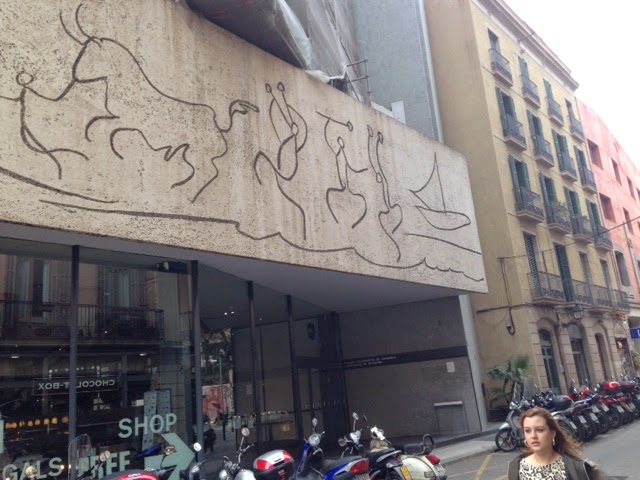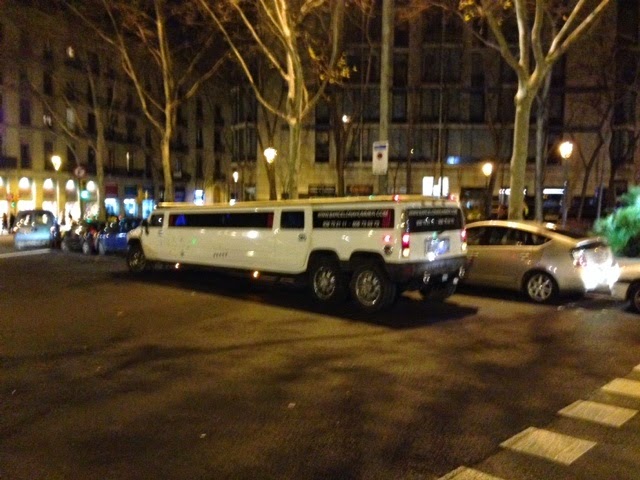Here we are waiting to start our walking tour centered around Picasso.
Our lovely tour guide - Gina giving a brief explanation of what the tour will entail. (One hour of walking around an area of Barcelona where Picasso lived and than an hour tour of the museum).
Picasso put on his one man show at this popular restaurant in 1900.
You will find this in front of the doors of many establishments which are over 100 years old. The symbols around the "name" are of the various guilds.
He even created the menu cover which is still used today.
When I first saw these on the building I thought they were children's sketches but no - Picasso's. Two of the facades are depicting life in Barcelona and the third is from his birthplace in Malaga, Spain.
The sailboat represents the Mediterranean. The figures are representative of Barcelonians's dancing the Sardana
and the musicians.
This facade shows the human towers and the gegants and children with Palms depicting Palm Sunday.
This is a depiction of bull fighting which is a big sport in Malaga
Just saw this as I was passing by and snaped a quick photo. Gina kept a fast pace.
 This is the oldest and most traditional chocolate shop in Barcelona. Since the 19th century gentlemen with walking canes have dropped by here for their chocolate fix. Unfortunatelly due to the rising rents the shop will be closing in a few months.
This is the oldest and most traditional chocolate shop in Barcelona. Since the 19th century gentlemen with walking canes have dropped by here for their chocolate fix. Unfortunatelly due to the rising rents the shop will be closing in a few months. Place de sant Josep Oriel is an artist's hangout. The artists display their pictures on the weekend showcasing their original works.
Ahead on the right , El Ingenio's , has been trading festival-related goods for the people of Catalonia since 1838. Beyond the cacophony of puppets, poi, gargantuan fetival heads,Carnival masks and joke-shop paraphernalia lies a family run business spanning generations. Over the years the family has counted the likes of Salvador Dali and the Cirque du Soleil as clients.
 While trying to get thi picture without people standing around it I was delayed and lost the group. I wasn't the only one. A young couple also got lost so we headed out to the corner and could see no one. I kept looking for Sharon's silver hair as that is how I can ususlly spot her. No hair, no where! We were also losing our audio. The young man knew the direction f the museum so we headed in that direction and I had picked up her directions to the group to cross this street and take a right and than a left at the corner and believe it or not we were once again back with our group.
While trying to get thi picture without people standing around it I was delayed and lost the group. I wasn't the only one. A young couple also got lost so we headed out to the corner and could see no one. I kept looking for Sharon's silver hair as that is how I can ususlly spot her. No hair, no where! We were also losing our audio. The young man knew the direction f the museum so we headed in that direction and I had picked up her directions to the group to cross this street and take a right and than a left at the corner and believe it or not we were once again back with our group. This is one of the places Picasso lived when a young man in Barcelona. There was some debate as to which house on the corner he actually lived in but police records confirm that this house directly below and not the next one. (Aparently they were partiers, and police were called on numerous occasions at the request of neighbors. ) They were literly starving artists. But to make their place "homey" they painted pictures of sofas , chairs and even servants on the walls. None of those paintings exist today and the building is empty and actually a condemned building.
Barcelona Head was created for the 1992 Olympics by American Pop artist Roy Lichtenstein. It brings together the colors of Miro, the tiles of Gaudi, the Cubism of Picasso, and the comic-newsprint trademark of Lichtenstein.
The Art Institute that Picasso attended at the age of 15. He was the youngest student. To gain admittance he had to present two pieces of his art works. His father was an instructor at the school and wanted his son to be the artist for the Royal Famiy. Never did achieve that goal. Poor guy!
The famiily lived in this building which is located across from the Institute.
This 14th century church, Santa Maria del Mar, is the proud centerpiece of the El Born area. "Del Mar" means of the sea and that's where the money came from. This is where shipwrights and merchants came to worship. This will be a future visit and willl write more about the church then.
Below you see the Monument of Catalan Independence. The square is called Place del Fossar de les Moreres )"The Burial Place of the Mulberry Trees".) The lone mulberry tree and modern monument honor a 300-year-old massacre that's still fresh in the Catalan consciousness. On September 11, 1714, the Boubon King Philip V, ruling from Madrid, completed a successful 14-month seige of Barcelona. In retaliation for the local resistance to Boubon rule, he massacred Catalan patriots. From that day on , the king outlawed Catalan language, culture, and institutions, kicking off more than two centuries of cultural suppression. This square marks the site of a mass grave of the massacred Catalan patriots. The eternal flame burns atop this monument and 9/11 remains a sobering anniversary for the Catalans, who still hold a grudge. They say when heading to the toilet, "I'm going to Philip's house."
The Picassoo Museum is located on Carrer de Montcada which was named for the Montcada family who owned the buildings that now house the museum( which consists of 5 mansions laced together). Because it connected the wealthy merchant district right near the waterfront with the tradsmen's quarter farther north, this drag attracted an elite class of homeowners during the 15th century heyday and is lined with many noble palaces.
Here we are waiting for the tour to begin. No pictures were allowed during the tour. The museum holds the best work of Pablo Picasso in Spain. Picasso spent his formative years ( 14-23) in Barcelona and it's the best collection of his early works anywhere. This museum is sparse on later and better works from his time of international celebrity. Instead it gives you an intimate portrait of the young man finding his way as an artist. Gina gave us an excellent tour of the museum hitting on the highlights of Picasso's life and the influence those factors had on his painting.
Leaving the museum we happened upon this wonderful little wine and tapa's place and stopped to have a itte beverage and rest from our two hour walking tour. We liked the atmosphere so much we decided to supplement the wine with a little food which turned out to be very tasty.
After leaving the little bar we walked around the area a bit more hoping to eventually run into a place we knew so we could get to a metro stop and get home. We didn't find a place we were familiar with but we eventually found a Metro stop and were able to make our way home for the night.
this Arc de Triomf (Catalan) was built as the main access gate for the 1888 Barcelona World Fair by architect Joseph Vilasecal i Casanovas.
I really wanted to take this hummer but we weren't sure if the three of us would fit so we continued on our way to the metro.


















































No comments :
Post a Comment